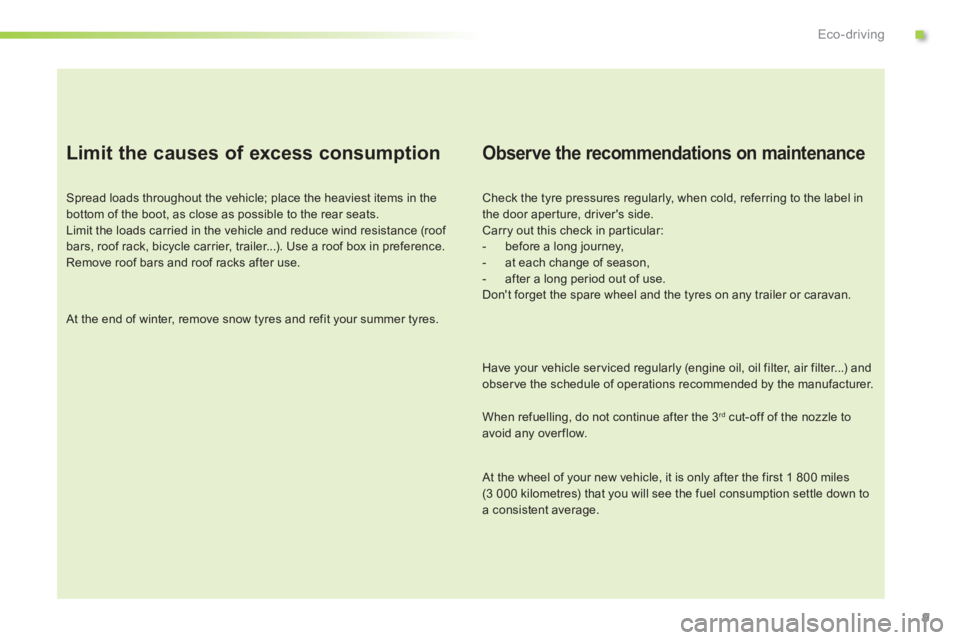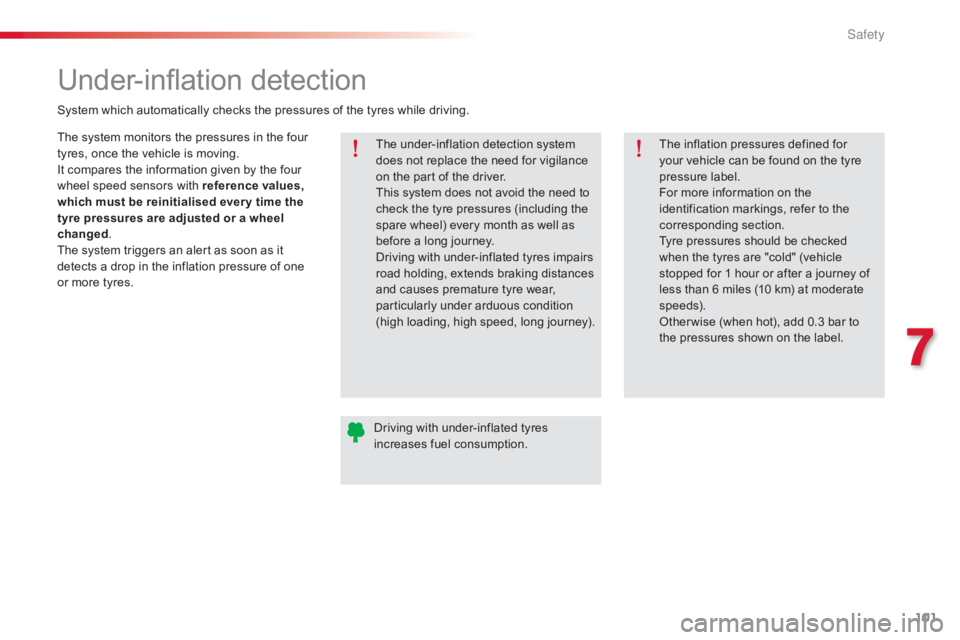change wheel CITROEN C-ELYSÉE 2016 Owners Manual
[x] Cancel search | Manufacturer: CITROEN, Model Year: 2016, Model line: C-ELYSÉE, Model: CITROEN C-ELYSÉE 2016Pages: 260, PDF Size: 7.11 MB
Page 11 of 260

9
Eco-driving
Limit the causes of excess consumption
Spread loads throughout the vehicle; place the heaviest items in the bottom of the boot, as close as possible to the rear seats.
Limit
the loads carried in the vehicle and reduce wind resistance (roof
b
ars, roof rack, bicycle carrier, trailer...). Use a roof box in preference.
Remove
roof bars and roof racks after use.
At
the end of winter, remove snow tyres and refit your summer tyres.
Observe the recommendations on maintenance
Check the tyre pressures regularly, when cold, referring to the label in the door aperture, driver's side.
Carry
out this check in particular:
-
b
efore a long journey,
-
a
t each change of season,
-
a
fter a long period out of use.
Don't
forget the spare wheel and the tyres on any trailer or caravan.
Have
your vehicle serviced regularly (engine oil, oil filter, air filter...) and
o
bserve the schedule of operations recommended by the manufacturer.
When
refuelling, do not continue after the 3
rd cut-off of the nozzle to a
void
any
over flow.
At
the
wheel
of
your
new
vehicle,
it
is
only
after the first 1 800 miles
(
3 000
kilometres)
that
you
will
see
the
fuel
consumption settle down to
a
consistent
average.
.
Page 88 of 260

86
C-elysee_en_Chap05_conduite_ed01-2016
F Turn thumb wheel 1 to the
"LIMIT" position:
the speed limiter
m
ode is selected but is not switched on
(
PAUS E).
You
do not have to switch the speed limiter
o
n in order to set the speed.
Programming Leaving limiter mode
F Turn thumb wheel 1 to the "0" position: t
he speed limiter mode is deselected. The
d
isplay returns to the distance recorder.
On
a steep descent or in the event of
s
harp acceleration, the speed limiter
w
ill not be able to prevent the vehicle
from
exceeding the programmed speed.
To
avoid any risk of jamming of the
ped
als:
-
e
nsure that the mat is secured
c
o r r e c t l y,
-
d
o not fit one mat on top of another.
In
the event of a speed limiter fault, the speed
i
s cleared and the dashes then flash.
Have
it checked by a CITROËN dealer or a
q
ualified
w
orkshop.
Operating fault
F Set the speed value by pressing button 2 or 3 (e.g.: 55 mph (
90 km/h)).
You
can then change the programmed speed using buttons 2 and 3:
-
b
y + or - 1 mph (km/h) = short press,
-
b
y + or - 5 mph (km/h) = long press,
-
i
n steps of + or - 5 mph (km/h) = maintained press.
Exceeding the programmed speed
Pressing the accelerator pedal to exceed the programmed speed will not have any effect unless you press the pedal firmly past the point of
resistance .
The
speed
limiter
is
deactivated
temporarily
and
the
programmed
speed,
w
hich is still displayed, flashes, accompanied by an audible signal.
Returning
to the programmed speed, by means of intentional or
u
nintentional deceleration of the vehicle, automatically cancels the
f
lashing of the programmed speed and the audible signal stops.
F
S
witch the speed limiter back on by pressing button 4
ag
ain.
F
S
witch the speed limiter on by pressing button 4
.
F
S
witch the speed limiter off by pressing button 4
: the display
c
onfirms that it has been switched off (PAUSE).
Driving
Page 90 of 260

88
C-elysee_en_Chap05_conduite_ed01-2016
F Turn thumb wheel 1 to the
"CRUISE" position:
the cruise control
m
ode is selected but is not switched on
(
PAUS E).
Programming
You can then change the programmed speed using buttons 2 and 3:
- b y + or - 1 mph (km/h) = short press,
-
b
y + or - 5 mph (km/h) = long press,
-
i
n steps of + or - 5 mph (km/h) = maintained press. When
the cruise control is switched on,
b
e careful if you maintain the pressure
o
n one of the programmed speed
c
hanging buttons: this may result in a
v
ery rapid change in the speed of your
v
ehicle.
Do not use the cruise control on
slippery
roads or in heavy traffic.
On
a steep descent, the cruise control
w
ill not be able to prevent the vehicle
from
exceeding the programmed speed.
To
avoid any risk of jamming of the
ped
als:
-
e
nsure that the mat is secured
c
o r r e c t l y,
-
n
ever fit one mat on top of another.
In
the event of a cruise control malfunction,
t
he speed is cleared resulting in flashing of the d
ashes. Have it checked by a CITROËN dealer o
r a qualified workshop.
Operating fault
Leaving cruise control mode
F Turn thumb wheel 1 to the "0" position: the cruise control mode is d
eselected. The display returns to the distance recorder.
Exceeding the programmed speed
Intentional or unintentional exceeding of the programmed speed results in flashing of this speed in the screen.
Return
to the programmed speed, by means of intentional or
u
nintentional deceleration of the vehicle, automatically cancels the
f
lashing of the speed.F
S
et the programmed speed by
a
ccelerating to the required speed,
t
hen press button 2 or 3 (e.g.: 70 mph
(
110 km/h)).
F
S
witch off the cruise control by pressing button 4
: the screen
c
onfirms that it has been switched off (PAUSE).
F
S
witch the cruise control back on by pressing button 4
ag
ain.
Driving
Page 103 of 260

101
C-elysee_en_Chap07_securite_ed01-2016
Under-inflation detection
The under-inflation detection system d
oes not replace the need for vigilance
o
n the part of the driver.
This
system does not avoid the need to
c
heck the tyre pressures (including the
s
pare wheel) every month as well as
b
efore a long journey.
Driving
with under-inflated tyres impairs
r
oad holding, extends braking distances
a
nd causes premature tyre wear,
p
articularly under arduous condition
(
high loading, high speed, long journey).The
inflation pressures defined for y
our vehicle can be found on the tyre
p
ressure label.
For
more information on the
i
dentification markings, refer to the
c
orresponding
s
ection.
Tyre
pressures should be checked
w
hen the tyres are "cold" (vehicle
s
topped for 1 hour or after a journey of
l
ess than 6 miles (10 km) at moderate
s
peeds).
Other wise
(when hot), add 0.3 bar to
t
he pressures shown on the label.
Driving
with under-inflated tyres
i
ncreases fuel consumption.
System
which
automatically
checks
the
pressures
of
the
tyres while driving.
The
system
monitors
the
pressures
in
the
four
t
yres,
once
the
vehicle
is
moving.
It
compares
the
information
given
by
the
four
w
heel
speed
sensors
with
reference values,
which must be reinitialised ever y time the
tyre pressures are adjusted or a wheel
changed .
The
system
triggers
an
alert
as
soon
as
it
d
etects
a
drop
in
the
inflation
pressure
of
one
o
r
more
tyres.
7
S
Page 147 of 260

145
C-elysee_en_Chap09_info-pratiques_ed01-2016
Spare wheel
The tools are installed in the boot under the fl o o r.
To
gain access to them:
F
o
pen the boot,
F
l
ift the floor and remove it.
F
r
emove the storage box containing the
to
ols.
Access to the tools
List of tools
Procedure for changing a wheel with a punctured tyre for the spare wheel using the tools provided with the vehicle.
T hese tools are specific to your vehicle and
c
an vary according to the level of equipment.
D
o not use them for any purpose other than
d
etailed
belo
w.
1.
W
heelbrace.
F
or removing the wheel trim and removing
t
he wheel bolts.
2.
J
ack with integral handle.
F
or raising the vehicle.
3.
W
heel bolt cover removal tool.
F
or removing the wheel bolt cover on alloy
w
heels.
4.
T
owing eye.
For
more information on towing, refer to the
c
orresponding
s
ection.
The
jack must only be used to change a
w
heel with a damaged tyre.
The
jack does not require any
m
aintenance.
The
jack conforms to European
l
egislation, such as defined in the
M
achinery Directive 2006/42/CE.
9
Practical information
Page 151 of 260

149
C-elysee_en_Chap09_info-pratiques_ed01-2016
F Place the foot of the jack 2 on the ground a
nd ensure that it is directly below the
f
ront A or rear B jacking point provided on
t
he underbody, whichever is closest to the
w
heel to be changed. F
E xtend the jack 2 until its head comes into contact with the jacking point A or B used; the v
ehicle’s contact sur face at A or B must engage with the central part of the head of the jack.
F
R
aise the vehicle until there is sufficient space between the wheel and the ground to admit the
s
pare (not punctured) wheel easily.
Ensure
that the jack is stable. If the ground is slippery or loose, the jack might slip or drop -
R
isk of injury!
Take
care to position the jack only at one of the vehicle’s jacking points A or B
under the vehicle,
e
nsuring that the contact sur face of the vehicle’s jacking point is centred on the head of the jack.
O
ther wise there is a risk of damage to the vehicle and/or that the jack might drop - Risk of injury!
9
Practical information